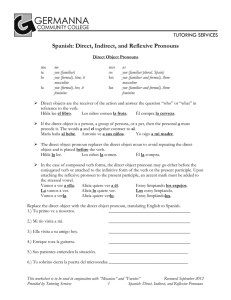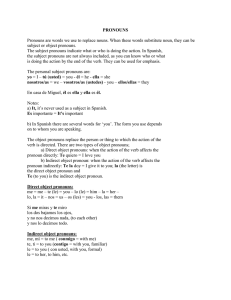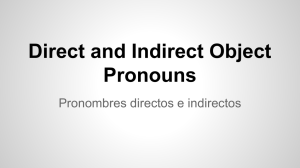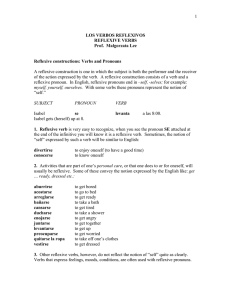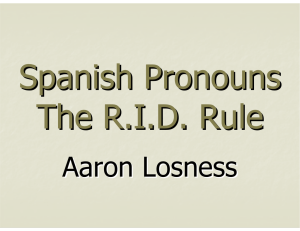Spanish: Direct, Indirect, and Reflexive Pronouns
Anuncio
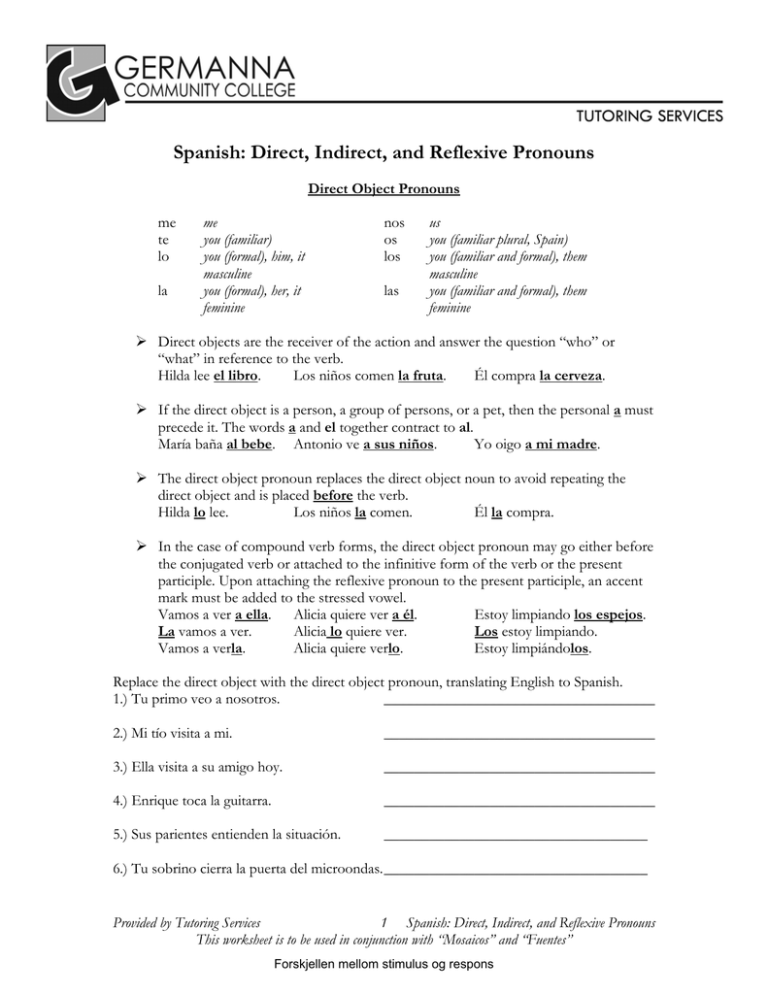
Spanish: Direct, Indirect, and Reflexive Pronouns Direct Object Pronouns me te lo la me you (familiar) you (formal), him, it masculine you (formal), her, it feminine nos os los las us you (familiar plural, Spain) you (familiar and formal), them masculine you (familiar and formal), them feminine ¾ Direct objects are the receiver of the action and answer the question “who” or “what” in reference to the verb. Hilda lee el libro. Los niños comen la fruta. Él compra la cerveza. ¾ If the direct object is a person, a group of persons, or a pet, then the personal a must precede it. The words a and el together contract to al. María baña al bebe. Antonio ve a sus niños. Yo oigo a mi madre. ¾ The direct object pronoun replaces the direct object noun to avoid repeating the direct object and is placed before the verb. Hilda lo lee. Los niños la comen. Él la compra. ¾ In the case of compound verb forms, the direct object pronoun may go either before the conjugated verb or attached to the infinitive form of the verb or the present participle. Upon attaching the reflexive pronoun to the present participle, an accent mark must be added to the stressed vowel. Estoy limpiando los espejos. Vamos a ver a ella. Alicia quiere ver a él. La vamos a ver. Alicia lo quiere ver. Los estoy limpiando. Vamos a verla. Alicia quiere verlo. Estoy limpiándolos. Replace the direct object with the direct object pronoun, translating English to Spanish. 1.) Tu primo veo a nosotros. ____________________________________ 2.) Mi tío visita a mi. ____________________________________ 3.) Ella visita a su amigo hoy. ____________________________________ 4.) Enrique toca la guitarra. ____________________________________ 5.) Sus parientes entienden la situación. ___________________________________ 6.) Tu sobrino cierra la puerta del microondas. ___________________________________ Provided by Tutoring Services 1 Spanish: Direct, Indirect, and Reflexive Pronouns This worksheet is to be used in conjunction with “Mosaicos” and “Fuentes” Forskjellen mellom stimulus og respons Indirect Object Pronouns me te le to/for me to/for you (familiar) to/for you (formal), him, her, it nos os les to/for us to/for you (familiar, Spain) to/for you (plural), them ¾ An indirect object tells “to whom” or “for whom” in relation to the verb. Mi madrastra compra la ropa para mí. Escribo las cartas a la revista. Mi madrastra me compra la ropa. Le escribo las cartas a la revista. ¾ In the case of compound verb forms, the indirect object pronoun may go either before the conjugated verb or attached to the infinitive form of the verb or the present participle. Voy a cocinar paella para mi hermano y su esposa. Les voy a cocinar paella. Estoy cocinando paella para ustedes. Voy a cocinarles paella. Les estoy cocinando paella. Estoy cocinándoles paella. ¾ The indirect object pronouns must always be used even if the indirect object is stated. Use the preposition a to clarify le and les. Also use a mí, a tí, a nosotros/as, a vosotros/as to place emphasis on the indirect object. Pepe regala flores a su madre. Tomas da el dinero a mí. Pepe le regala flores a su madre. Tomas me da el dinero a mí. Replace the indirect object with the correct indirect object pronoun. 1.) Mi novio da su tarjeta de crédito a mí. ____________________________________ 2.) Debo leer más libros a mis niños. ____________________________________ 3.) Tiene que limpiar la casa para su madre. ____________________________________ 4.) Vende flores a la gente. ________________________________________________ 5.) No dice nada a mí. ________________________________________________ 6.) No doy dinero a ella. ________________________________________________ 7.) A veces ella escribe una carta a ellos. ____________________________________ 8.) Estamos comprando una pulsera y ese arete para nuestra abuela. __________________________________________________________________ Provided by Tutoring Services 2 Spanish: Direct, Indirect, and Reflexive Pronouns This worksheet is to be used in conjunction with “Mosaicos” and “Fuentes” Reflexive Pronouns me te se yo tú (familiar) él, ella, Usted nos os se nosotros/as vosotros/as ellos, ellas, Ustedes ¾ Reflexive verbs state what someone does “to” or “for” herself or himself. ¾ Reflexive verb pronouns refer back to the subject of the sentence; they agree with the subject of the verb. ¾ When talking about parts of the body or articles of clothing, use definite articles such as el, la, los, and las. ¾ Reflexive pronouns are equivalent to the English pronouns myself, yourself, himself, herself, ourselves, yourselves, and themselves. Se ducha antes de acostarse. Te quitas los zapatos cerca de la puerta. ¾ Infinitive verbs with –se attached are the reflexive form of the verb. prepararse dormirse darse cuenta de (to realize) ¾ The reflexive pronoun goes before the conjugated verb. In the case of compound verbs and the present progressive, the reflexive pronoun goes either before the conjugated verb or attached to the infinitive or the present participle. Upon attaching the reflexive pronoun to the present participle, an accent mark must be added to the stressed vowel. Translate the following sentences from English to Spanish using reflexive pronouns. 1.) We comb our hair. ________________________________________________ 2.) They wash their hands. _______________________________________________ 3.) I wake up early. ________________________________________________ 4.) Michael shaves in the morning. ____________________________________ 5.) She sits in the chair near the window. ____________________________________ 6.) You take off your shoes. __________________________________________ 7.) Pam puts on make-up in the bathroom. 8.) José lays down every day at one. ______________________________ ____________________________________ Provided by Tutoring Services 3 Spanish: Direct, Indirect, and Reflexive Pronouns This worksheet is to be used in conjunction with “Mosaicos” and “Fuentes” R.I.D. Reflexive, Indirect Object Pronoun, Direct Object Pronoun ¾ When there are two object pronouns in a sentence, they will appear in the R.I.D. order: reflexive, indirect, and direct. ¾ Two is the maximum number of pronouns that can occur in a sentence together. The combinations that may occur are reflexive-indirect (rare), reflexive-direct, or indirect-direct. ¾ Keep in mind that object pronouns are used in referring to previously mentioned information in paragraphs and conversations. Reflexive-Direct Me lo pongo. I put it on. Tus uñas son bonitas. Your fingernails are pretty. Indirect-Direct Sara me los mandó. Sara sent them to me. Me lo dijo. She said it to me. ¿Te las pintas a menudo? Do you paint them often? Te las venden. They sell them to you. ¾ If both the direct and indirect object pronouns occur together in the third person (lo, la, los, las – le, les), then change the indirect object pronoun to se. Manolo le vendió el carro a Gloria. Manolo se lo vendió. Lucas les regaló las flores a Los Garcia. Él se las regaló. ¾ In sentences using compound verbs, the same order, R.I.D., applies in the placement of the pronouns. The object pronouns may either be placed before the conjugated verb or attached to the infinitive. Translate from English to Spanish using the correct object pronouns. 1.) We bought them for her. ________________________________________________ 2.) I wrote it for him. ________________________________________________ 3.) They have to make them for the girls. 4.) He wants to read it to us. ____________________________________ ________________________________________________ 5.) Mrs. Iglesias loves her dogs. __________________________________________ 6.) Why do you give them to me? __________________________________________ Provided by Tutoring Services 4 Spanish: Direct, Indirect, and Reflexive Pronouns This worksheet is to be used in conjunction with “Mosaicos” and “Fuentes”
